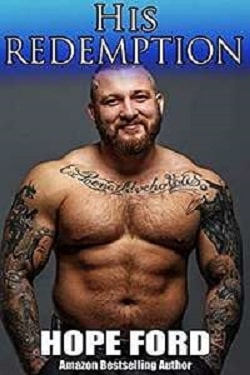By six, all evidence was cleared away. I showered in the studio bathroom, watching paint and other residue swirl down the drain in a hypnotic spiral. The hot water pounded against my shoulders, sluicing away Ezra the artist, leaving behind Ezra the professor.
I dressed in the clothes I kept in the studio closet: tailored charcoal slacks, a crisp white undershirt, an emerald cashmere sweater, shoes hand-polished to a subtle shine, and of course my signature burgundy tie. The uniform of a tenured professor with artistic sensibilities.
In the mirror, I studied my reflection, adjusting my expression until the smile came easily and I no longer looked like Ezra the hunter, but Ezra the teacher.
My students responded to the persona I curated, especially the lost boys. They came looking for structure, for someone to say no and mean it. Not many understood that discipline was a kind of devotion.
"Professor Bishop," I murmured to my reflection, testing the mask I would wear for the day. "Welcome to a new semester." My voice sounded different up here, warmer, more resonant in the bathroom's acoustics than in the dead air of the soundproofed studio below.
Behind the careful composure, something hungry stared back at me from the mirror. A god gets lonely, even when surrounded by worshippers. Perhaps Micah would be different. Not just another supplicant, but a true acolyte worthy of communion.
My phone buzzed again. A text from the gallery owner, asking about progress on the final piece for the exhibition. I replied with vague reassurances about artistic process and inspiration, knowing she would accept any explanation that maintained the mystique she used to market my work.
As I drove from my secluded home toward campus, dawn painted the sky in gradient shades of orange and blue. The leather of my steering wheel was cool beneath my palms, the purr of the engine a counterpoint to the Bach cello suite playing softly through the speakers. There was something beautiful about a fresh start with familiar echoes of the past.
I parked in the faculty lot, straightened my collar, and stepped into the cool morning air. The campus smelled of freshly cut grass and stone warmed by early sunlight. Students milled about the quad, eager and apprehensive on their first day. They watched me, some with admiration, others with trepidation. My reputation preceded me: brilliant but demanding, inspiring, yet intimidating.
I savored the duality, this life balanced on the edge between revelation and concealment. By day, I would guide young artiststoward technical proficiency and conventional success. By night, I would continue my true work, pushing beyond the accepted boundaries of art and mortality.
And perhaps, if Micah Salt proved as interesting as his application suggested, I might find someone worthy of sharing more than just classroom knowledge.
I didn't merely want to kill him or capture him in paint. I wanted to see himbecome. The opportunity to witness that rare metamorphosis as a student embraced their darkness was its own reward. But being able to guide that process, shape it? That was power.
And something told me Micah Salt wasn't just another student. He could be the one—my greatest work. Not beneath my blade.Besideme.
Micah
I stepped back fromthe canvas with a frown.
St. Sebastian hung suspended in exquisite agony, arrows piercing his flesh, his face turned skyward in transcendent suffering. The technical execution was immaculate. I’d captured the perfect balance between light and shadow, the subtle tension in every muscle, the moment where agony transformed into ecstasy. I'd spent weeks on it, perfecting every brushstroke, every subtle gradation of color.
It was beautiful.
Too beautiful.
Something dark and cold stirred inside me, spreading through my veins until my fingertips tingled. The perfection of the image mocked me, trapped suffering in aesthetic beauty that diminished its truth. The saint's serene expression lied about the nature of pain.
I reached for the palette knife on my workbench. The familiar weight of it grounded me, cooled the panicked heat rising to the surface. For a moment, I simply stood before the canvas, knife poised, watching my reflection distorted in its surface.
The first cut into the face of St. Sebastian felt like releasing a scream I'd been holding since childhood. The canvas gave way beneath the blade with a sound like tearing flesh, a resistance and then surrender that sent a shudder of pleasure down my spine. I dragged the knife downward, peeling away layers of paint to expose the raw canvas beneath.
I didn't stop with one cut. I worked with methodical violence, scraping away the face until nothing remained but a ragged void. Where his features had been, there was now only absence, a wound in the canvas that felt more honest than any expression I could have painted.
Not satisfied with only the knife, I reached for the turpentine. I poured it directly onto what remained of the face, and let the chemicals dissolve years of technique, the careful layering of pigments melting into rivulets that ran like tears, transforming the composition into something alive. My painting was no longer a static image, but a moment of violent becoming.
In some places, I used a lighter, burning small sections until the canvas blackened and curled. The scent of burning linseed oil and acrylic filled the studio, acrid and intoxicating.
My breath came in short, controlled bursts as I worked, a rhythm learned through years of containing whatever lived inside me. This wasn't random destruction but a deliberate unmaking, a revelation through ruination.
This was the third canvas I'd transformed this week. Each time, I'd painted a saint, then torn their face away. Each destruction felt like lancing a boil. Painful, necessary, and strangely satisfying. My thesis advisor called it "artistic catharsis." My therapist called it "expressing unresolvedtrauma." Neither of them really understood. The ruination wasn't an expression of anything. It was a containment strategy. A controlled release of pressure before something worse burst forth.
I stepped back, surveying the transformation. The once-immaculate painting now featured a gaping wound where divinity should have been, arrows still piercing a body whose identity had been obliterated. Where the face had been, paint thinner continued to dissolve the layers, creating a melting, weeping effect that seemed to animate the figure. Around this void, the remaining elements gained power, intensity, as if feeding off the absence at their center.
The technique was perfect. My grandmother had ensured that, funding art lessons from the moment my talent emerged. Painting was the only acceptable outlet for a boy with my... peculiarities.
My phone chimed, breaking the silence of my small apartment studio. The reminder flashed across the screen: Meeting with Professor Bishop, 10:00 AM.
My heart rate accelerated. Being selected as Ezra Bishop's protégé was both an honor and a terror. His reputation at Ravencrest was legendary. Brilliant, demanding, transformative. His own exhibitions commanded international attention, though he'd become increasingly selective about where and when he showed his work. The chiaroscuro series he was currently working on had the art world buzzing with anticipation months before its debut.















